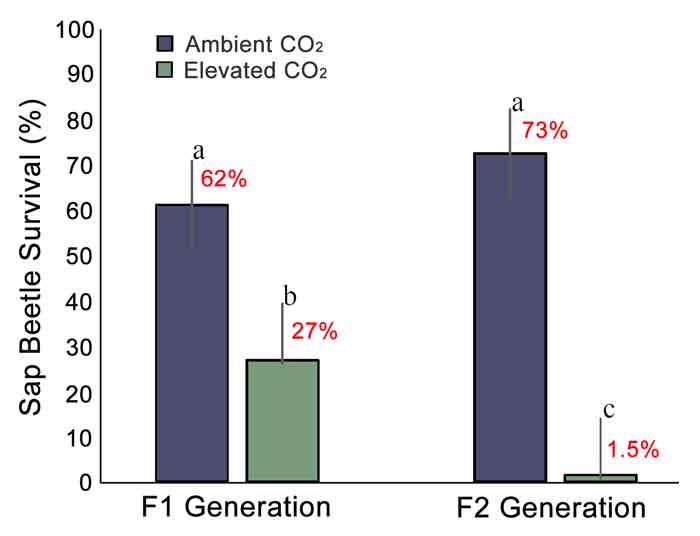| Tweet | Follow @co2science |
Paper Reviewed
Nor-Atikah, A.R., Halim, M., Nur-Hasyimah, H. and Yaakop, S. 2020. Evaluation of colour changes, survival rate and life span of the confused sap beetle (Carphophilus mutilatus) (Coleoptera: Nitidulidae) in different concentrations of carbon dioxide (CO2). Applied Ecology and Environmental Research 18: 6443-6455.
In providing the rational for their work Nor-Atikah et al. (2020) write "nitidulid beetles in the genus Carpophilus are important pests of dried fruit worldwide but have recently also become serious pests of ripening stone fruit in southern Australia, as well as palms, including dates and oil palm fruits [where] adult beetles damage fruit either by chewing through the skin, usually at the stem end, or entering from the sites of mechanical damage." Consequently, they say it is important to gather biological information regarding the life cycle, life span and mortality rates under varying environmental conditions so as to develop control programs. And so it was that this team of four Malaysian researchers set out to investigate the effects of elevated CO2 on the color change, life span and survival rate of the confused sap beetle (Carpophilus mutilatus).
The experiment was conducted under controlled conditions at the Center for Insect Systematics Laboratory, Universiti Kebangsaan Malaysia, where beetles were reared under two CO2 concentrations, ambient (~355 ppm) or elevated (~875 ppm), for two generations (F1 and F2). In describing their findings Nor-Atikah et al. report there was "no obvious change in body color" due to elevated CO2 conditions as beetle morphology progressed from the larval to adult stages. Life span, in contrast, was found to be impacted by CO2 such that under ambient CO2 conditions this parameter averaged 46 days in both the F1 and F2 generations, whereas under elevated CO2 life span was shortened to 30 days in the F1 generation and 22 days in the F2 generation.
Perhaps the most significant finding, however, was that observed for survival rate. As illustrated in the figure below, beetle survival rate under ambient CO2 conditions was 62% in the F1 generation and rose to 73% in the F2 generation. By contrast, survival rate of beetles in the elevated CO2 treatment was a mere 27% in the F1 generation and an infinitesimal 1.5% in the F2 generation. Thus, elevated CO2 reduced the survival rate by 57% in the F1 generation and a whopping 98% in the F2 generation!
In light of the above, it would appear that herbivore impacts of the confused sap beetle will be tremendously reduced in the future as the air's CO2 concentration rises. And that is great news for those who grow and consume plants affected by this pest.

Figure 1. Percent survival rates of the confused sap beetle across generations under ambient or elevated CO2 concentrations. Adapted from Nor-Atikah et al. (2020).




